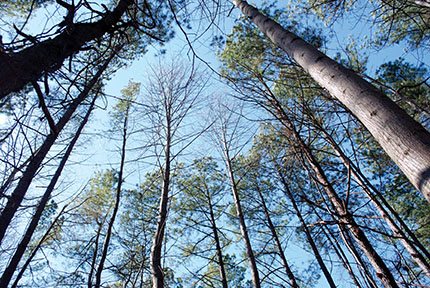Charlotte City Council Environment Committee examines tree canopy goal
At their February 14th meeting, the Charlotte City Council Environment Committee were presented with the results of the recent tree canopy assessment, an overview of current tree programs and initiatives, and considerations toward adopting an appropriate tree canopy goal(s).

According to the assessment, the tree canopy percentage is 46.8 percent using 2016 data. This is down from 47.1 percent in 2012, the last time the tree canopy was assessed. The percentage difference equates to 400 – 520 acres of lost trees.
Nicknamed “The City of Trees,” Charlotte is well known nationally for its urban tree canopy. For 38 years in a row, Charlotte has been named a Tree City USA by the Arbor Day Foundation. In 2013, American Forests ranked Charlotte among the top 10 cities for its tree canopy.
Trees contribute to our community in a variety of ways as described in a piece from UNC Charlotte Urban Institute:
- Locally, officials estimate trees prevent at least 9,000 pounds of air pollution and reduce carbon dioxide by 35 million pounds.
- City residents save an estimated $1.04 million annually in heating and cooling costs, with the greatest amounts of savings provided by willow oaks.
- When it rains, trees intercept an estimated 2.7 million gallons of storm water generated by development.
- The aesthetic value of trees increased residential property values by more than $4 million.
In 2011, the Charlotte City Council adopted a “50 percent by 2050” policy to grow the tree canopy across the city in response to studies showing that the tree canopy was disappearing faster than it was being replanted. Mecklenburg County lost 33% of its tree canopy and 3% of its open space between 1985 and 2008, and has only half the parkland per person compared to the national average.
The Environment Committee is looking at potentially revising the 2050 goal. Options may include:
- Keeping “50% Tree Canopy in 2050” as the goal
- Setting another percentage goal
- Setting a numeric planting goal
- Setting a goal or goals that reflect the contributions that trees make to Charlotte’s variety of urban environments
They also discussed what make a good canopy goal?
- Inspirational yet Attainable
- Reflective of community values
- Reflecting urban forest quality as well as quantity
- Community-wide and also place-specific
- Fits the context of Charlotte
Our take
While there is a tree protection policy in place, it has not been strong enough to counter the losses. It’s important that we address the primary problem. Most of the tree canopy loss can be attributed to rapid development and sprawl. Our current policies related to trees are insufficient to reach our “50 percent by 2050” goals.
We must strengthen our ordinance to protect and expand our tree canopy. While some nuanced revisions can be helpful, we shouldn’t abandon our overall goal. We should look at all possible solutions including “No Net Loss” Policies.
Next steps
This process is expected to last several months. We will continue to provide updates and advocate for our tree canopy.
February 14, 2019 Environment Committee Agenda. Watch the video stream.
The Environment Committee will meet on 10-8-2018.
City Council Members in attendance:
- Dimple Ajmera, At-Large, Chair, Environment Committee
- Gregory A. Phipps, District 4, Member, Environment Committee
- Matt Newton, District 5, Member, Environment Committee
- Tariq Bokhari, District 6
Thanks for reading!
As a nonprofit, community support is essential for us to keep doing what we do — including providing free articles like this. If you found this article helpful, please consider supporting Sustain Charlotte.
Want to stay in the loop? Subscribe to our weekly newsletter and follow us on Instagram, Facebook, and Twitter.
